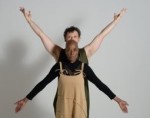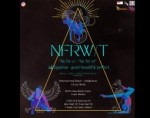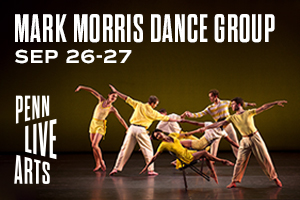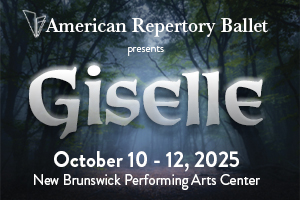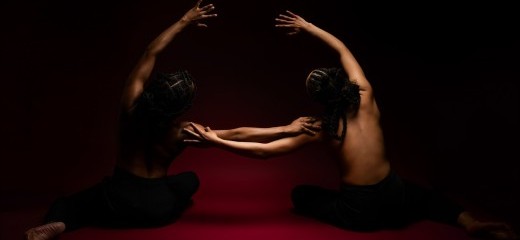
Seeking Sisterhood Amidst Unsafe Systems
by Caitlin Green
Sprinting onstage, Cierra Woods and Edwina Thertulien begin sis.tem | gateways to safehouses (by C. Woods Work). A full-throttle run to a fast-tempo lindy-hop tune keeps their feet in constant motion. Their high-energy kicking and shuffling is balanced with more grounded moves as a house track bleeds into the song and takes over, courtesy of Woods who shifts from dancing to DJing, adjusting knobs on the mixer. She blends lindy-hop with house, then house with hip-hop from a table at the back of the stage.
Thertulien continues dancing, actively and seamlessly adjusting to the groove, embodying it. It's unclear to me whether this moment is choreographed or improvised – either way, the dynamic and expressive dance carries a constant groove amidst the rhythmic shifts. Her flighty jive dance morphs to stabilized steps with emphasis on the house downbeat, from which a signature hip-hop vocabulary emerges. Thertulien’s bounce is accented with stops that respond to the rhythm and bass of the new tempo, which also features hints of jazz music. Woods joins in to what is now clearly choreographed phrasework, and they get down in their business casual get-ups: white button-down shirts tucked into brown slacks, with matching scarves around their necks.
An echoey soundscape, dark blue lights, and a shadowy projection create a new atmosphere for their movement, which transforms into a new repertoire. They reflect the tension that arrives in the audio, in their bodies – straining, stretching in different directions, expanding, pulling, reaching until they remove their scarves. They alternate with solos that feature pained facial expressions paired with a sense of heaviness and passive weight in their phrasework; a surrender to gravity, conveying exhaustion, discomfort, and frustration, before exiting the stage.
A few quiet moments pass before dancers return wearing loosely layered, breathable fabrics in shades of lavender. Their movement jerks and strains – a continuation of the tone that they left us with. Writhing and reaching, from standing synchrony to floorwork, the choreography is a display of their attunement to one another and a technical skill that flaunts a range of inversions, balance, strength, and flexibility amidst the abstract storytelling.
“Girl” by Destiny’s Child sounds through the speakers as Woods returns to her role as DJ. The song of sisterhood gives context to Thertulien’s jerky contractions and stumbling phrasework.
“Girl, I know you’ve been hurtin’ and needing somebody to talk to” ...I’m singing along in my seat. Woods mixes the track to a house beat featuring a woman’s voice who sings “this is my house”, followed by a Noname song.
What unfolds from here is a refreshing shift from dancers moving in parallel, separate but synchronized, to them moving with presence, connection, and intention. Woods returns to the floor, crawling beneath Thertulien who has been in constant motion, using her own body to give their dance partner a place to rest. Their bodies intersect and intertwine as they share each other’s weight. Their visual focus and movement impulses seem more attentive to one another than to the music. They see and respond to each other, now with an intimacy and a level of consideration which wasn’t previously displayed in the work.
Before the piece finishes, Woods and Thertulien place a box, a candle, and some palo santo center stage beneath projected text that reads, “What makes you feel most safe? Who are the sis.tem makers that influence you?” The audience is given pens and strips of paper to write and reflect, and we’re invited to place our answers in the box as offerings.
I originally believed this to be the end of the show, but the dancers return to the performance space to the sound of rising harmonies and bright ambient noise, leaving us with a tone of comfort, tenderness, support, and togetherness. Their touch and connection-based choreography sequences through lifts, eye contact, hand holding, and a soothing, rhythmic, reciprocal embrace.
sis.tem | gateways to safehouses journeys from an emphasis on structure and technique to one that centers closeness and interdependence, and creates a movement narrative that offers connection as one solution to unsafe systems.
sis.tem | gateways to safehouses, C. Woods Work, Icebox Project Space, Sept. 5-21.
Article and Homepage Image Description: Two dancers sit on a red floor in front of a black backdrop with their hair braided into updos with cornrows. They are topless with their bare backs facing the camera, wearing black leggings. They mirror each other, leaning toward one another with one hand outstretched, resting on the other’s shoulder. The other arm arcs overhead, also in the direction of the other.
By Caitlin Green
September 16, 2025


